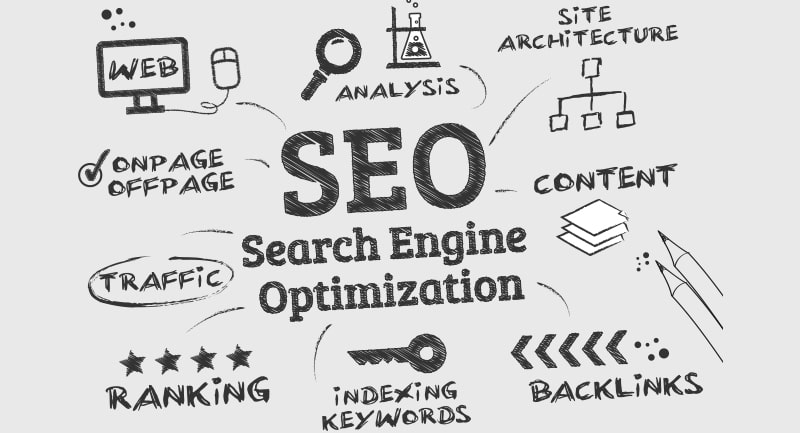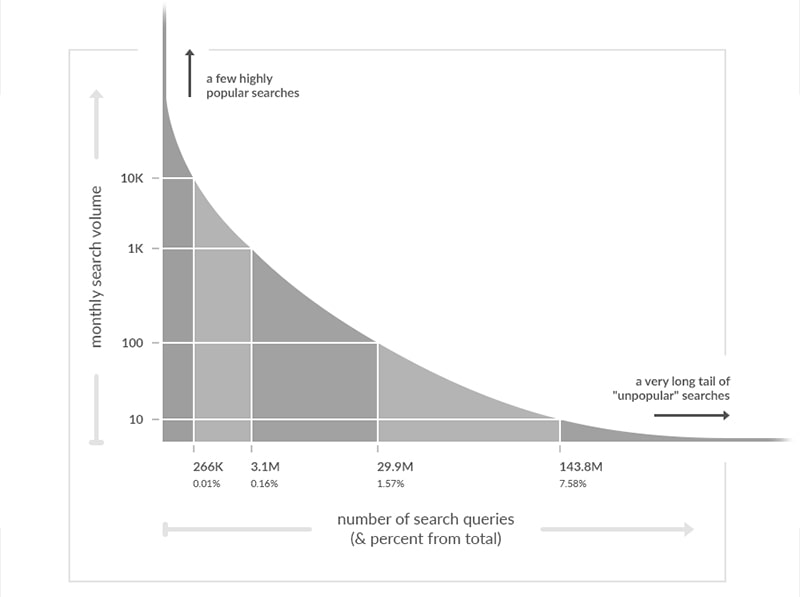SEO (Search Engine Optimization) is a process that includes all activities aimed at increasing the website visibility and improving its ranking in organic (i.e. not paid) search results; SEO in B2B has very similar logic.
It is, therefore a complementary aspect to Google Ads Search Campaigns, of which we have already talked about. While in the latter, the possibility to rank high in the search results will depend on the result of a virtual auction, the organic position reached in the SERPs will be “organic” and will result from targeted activities on the SEO side.
For B2B companies, SEO represents an essential customer acquisition channel.
If done right, it can generate rapid growth in visits to the company’s website, making it visible to users who are actively looking for products and services—all without ongoing financial investment in advertising.
But, what changes in terms of SEO practices when moving into an industrial B2B market? The audience, or target audience, is one of the main differentiators between B2B and B2C marketing.
Differences between B2B and B2C SEO
The way industries buy professional services is quite different from the way consumers do.
While in B2C (business-to-consumer), the buyer tends to be the end-user, the B2B (business-to-business) buying process involves multiple players from different departments, such as the technical and purchasing departments.
In terms of SEO, it is crucial to take these differences into account, especially when you need to address your target audience.
Unlike B2C marketing, where your audience is a group of people with the same buying interests (which make it easier to identify the search intent), in B2B, your target audience is a business with a much more complex buying process.

In this case, you’ll need to identify the decision-maker to target within the business, so that you can find the search query (keyword) used to find the product/service of their interest. For example, if the person who buys within the company is the purchasing department, but the person who proposes and searches for a solution in the market is a designer in the technical department, my marketing efforts should be directed towards the latter. He will then influence the purchasing department himself.
As you understand, good organic positioning is now critical to generating new business opportunities and will be increasingly so with the upcoming generations.
In short, with SEO, we’re going to act in the first steps of the acquisition funnel or customer journey, if you will.
Even B2B companies search for information, products and services online and in total autonomy.
To be there or not to be there makes the difference between sitting or not sitting at the table with the customer. We risk losing a business negotiation without even knowing it exists.
Influencing decision-makers opinions at this stage is now an essential aspect of the sales activities of all B2B companies.
That’s where keyword research comes in.
In business-to-business, you’ll probably have to work with low-volume keywords, meaning that the number of monthly searches is generally low because they are very specific. In addition, you’ll need to do a thorough analysis of the search terms that best identify your product so that they are in line with those used by your potential customers.
This will allow you to reach a more specific audience, attract quality traffic, and consequently generate more conversions on target on your site.
In fact, in B2B, it’s not uncommon for very poorly searched keywords to generate excellent business opportunities. That is the beauty of working in niche markets with high margins.
Building an SEO strategy for B2B

As with any business process, having a strategy is essential.
An SEO strategy must take into consideration several best practices, including:
- Optimize the site for both desktop and mobile;
- Optimize the site code, making it as understandable as possible to search engines (e.g., add meta tags);
- Upload content that is optimized for the web and that does not have too much of an impact on the website loading speed;
- Carefully choose which keywords to invest in, thus to direct your efforts to the right direction without wasting precious time;
- Monitor your ranking within the SERP and the traffic generated by the different online channels (Google, social, blog, etc.);
- Add internal and external links.
This last point should have made you realize that SEO activities are not limited to the website perimeter only.
In fact, SEO is divided into ON-PAGE, focused on the website’s elements (from keywords to the “alt text” of the images, to the meta description, to the texts, etc.), and OFF-PAGE, which is external to the site (among which backlinking stands out).
Keyword Research
To carry out proper keyword research (the words most important to your business), you’ll need to consider three main factors:
- Frequency, which is the number of times a term is searched for. Clearly, you must evaluate the search volumes in relation to the specificity of your business;
- Competition, since you probably won’t be the only one striving for the top positions in Google’s SERP in the free market. Getting them for the most competitive keywords can be challenging and require significant time and resources. For this reason, some SEO specialists prefer to focus on keywords with less competition, taking advantage of the so-called “long tail” terms, which often offers good opportunities at a lower price. In fact, on a given topic, only a tiny number of inflated keywords have a high search volume. Most have a low to medium search volume. To give an example, the keyword “engines” can have much competition and have the disadvantage of being ambiguous for the audience (B2B or B2C?). On the other hand, a more specific keyword such as “ATEX brushless servomotors” represents an excellent example of long tail term. It provides more detailed information to users and, consequently, offers good chances of conversion. Let’s remember that our goal is primarily to “convert”, meaning to lead the user from an interest to a purchase;
- Finally, the third and also the most crucial factor is relevance. The keywords you invest on for your website must correspond to what you offer. If, for example, a modelling hobbyist comes to your area looking for “micromotors” for his mini 4wd, but you sell “brushless micromotors” for industrial use, he will probably leave (or even worse, will make a request wasting our time). It is essential then that the keywords chosen correspond precisely to what users are looking for, the famous “search intent”.
Long-tail keywords are terms with low search volumes. Despite what many people think, it has nothing to do with how long or short a keyword is, how likely it is to convert or how specific it is. They are so-called because they fall on the long tail of the search demand graph.

If you were wondering how to find the best keywords for your audience, know that you can run an analysis with specialized tools like the Keyword Planner from Google Ads.
On-site SEO
With on-site SEO (or on-page), we intend all those optimizations that can be done within your site. In fact, it’s about inserting “aids” that Google will use to understand your site’s content and then position it correctly in the results pages. It will show it only when it is relevant to the research of its users.
Among these, we have the optimization of HTML code, keywords and meta tags analysis (title, description, H1, H2, etc..), content organization, URLs and images optimization (filename, alternative text for the visually impaired, file weight, etc..) and adding internal links that allow visitors to browse from one content to another while remaining in the same website, thus increasing its usability and the time spent within it (which is one of the KPIs of SEO).

On-site elements are not visible to users, but they are fundamental for Google. Crawlers or bots will analyze them and decide whether and how to rank them on the search results page (ranking or positioning phase).
Not everything that is found by the bots ends up in the index. For example, if search engines find content duplicates on different websites, they will have to choose which version to put in the index. For this reason, to rank well, it is essential to make unique and original content.
The main goal of search engines is to create a results page with maximum relevance and value in order to help users find what they are looking for. So, if your site provides content that is useful, interesting, well-written and follows Google’s guidelines, results will not be long in coming. Remember that SEO takes longer to deliver results than paid campaigns, so it’s a medium-to-long-term strategy.
Off-site SEO
On the other hand, off-site or off-page SEO concerns the optimizations that are carried out outside of your website, which helps improve its reputation and grant it greater popularity. In other words, it tells Google the opinion that users have about your website, and that is a ranking factor too.
An off-site SEO practice example is backlinking, aka having topic-related websites linking back to yours. It’s like getting a “recommendation”, but online. Many good-quality links to your pages prove its authority and trustworthiness and, consequently, will increase traffic.

The best way to get backlinks is to create original, quality content so that people visiting your website voluntarily share links to your content and cite you as the source.
In the same way, adding links on your website that point to trusted domains in line with your business will also improve your ranking and earn the trust of search engines.
For more information about Backlinking strategies in B2B industry, we created this article.
Conclusion
Even in the industrial world, nowadays, lead generation passes through digital channels.
Since organic traffic is one of the main channels (if not the most important) to bring users to our website, it becomes inevitable to invest in our presence on search engines, first of all, Google.
An SEO strategy in B2B is, therefore, a key piece of marketing and sales activities.
Start by understanding who your audience is, writing rich and relevant content that meets their needs and is, at the same time, optimized for search engines.






